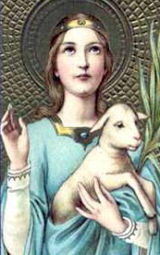Catholic Activity: Customs on the Feast of St. Agnes

DIRECTIONS
Customs in Italy Because of the similarity of her name to the Latin for "lamb" (agnus), the lamb has been St. Agnes' symbol since the 6th century. On the feast day, 21 January, the Trappist fathers of the Monastery of Tre Fontane (near Saint Paul's Basilica) provide two lambs from their sheepfold to the Benedictine nuns of Saint Cecilia. They arrive at Saint Agnes' Basilica wearing crowns, lying in "baskets decorated with red and white flowers and red and white ribbons—red for martyrdom, white for purity."
For the festal Mass, the church, titular cardinal, and concelebrants are decorated with red, white and gold. During the Mass, there is a procession of little girls veiled and dressed in white lace with pale blue ribbons, followed by four resplendent carabinieri carrying the baby lambs. The lambs are blessed and incensed before being taken to the Vatican for the Pope's blessing. Then they are delivered to the Convent of Saint Cecilia to become the pets of the sisters until Holy Thursday (when they are shorn) before being sacrificed on Good Friday.
The wool from these lambs is woven into 12 archbishops' palliums. The pallium is an older symbol of the papacy than the famed tiara. The elect becomes "Shepherd of Christ's Flock" when the pallium touches his shoulder and symbolizes that the new bishop is being 'yoked' with the bishop of Rome, who is visible head of the Church. About 204, Saint Felician of Foligno is the first recorded recipient of a pallium from a pope (Saint Victor I). (So, the concept of papal primacy was very old indeed.)







